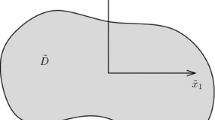Abstract
The Newtonian potential is used to solve an inverse problem in which we seek the shape of an inhomogeneity in an infinite elastic matrix under uniform applied stresses at infinity such that certain stress components are uniform on the boundary of the inhomogeneity. It is shown that ellipsoids furnish the solution of this inverse problem. Exact and general expressions for the stress and displacement are given explicitly for points in the elastic matrix outside the inhomogeneity. The solution of the corresponding plane deformation problem is found as a limiting case. Several applications are presented, and results from the literature are confirmed as special cases.
Similar content being viewed by others
References
G.P. Cherepanov, Inverse problems of the plane theory of elasticity.PMM 38, No. 6 (1974) 963–979.
L.T. Wheeler, On the role of constant stress surfaces in the problem of minimizing elastic stress concentration.Int. J. Solids and Struc. Vol. 12 (1976) 779–789.
L.T. Wheeler, The problem of minimizing stress concentration at a rigid inclusion.Journal of Applied Mechanics, 52 (1985) 83–86.
L.T. Wheeler, and I.A. Kunin, On voids of minimum stress concentration.Int. J. Solids and Structures 18 (1982) 85–89.
B.H. Eldiwany and L.T. Wheeler, On rigid inclusions of minimum stress concentration,J. Mech. Phys. Solids, 34 (1986) 19–28.
M.E. Gurtin, The Linear Theory of Elasticity,Handbuch der Physik, Vol. VI a/2, Springer-Verlag (1972).
O.D. Kellogg,Foundations of Potential Theory. Springer-Verlag (1953).
H. Lamb,Hydrodynamics, 6th ed., Cambridge Univ. Press (1932).
P.F. Byrd and M.D. Friedman,Handbook of Elliptic Integrals for Engineers and Scientists, 2nd ed.. Springer-Verlag (1971).
J.A. Osborn, Demagnetizing factors of the general ellipsoids.Phys. Rev., Vol. 67 (1945) 351–357.
J.D. Eshelby, Elastic inclusions and inhomogeneities,Progress in Solid Mechanics, I.N. Sneddon and R. Hill, eds., Vol. 2. North-Holland, Amsterdam, Holland (1961).
E. Daniele, Sul problema dell'equilibrio elastico nellθ spazio esterno ad un ellissoide, per dati spostamenti in superficie.Nuovo Cimento, Vol. 6, 1 (1911) 211–229.
W.D. MacMillan,The Theory of the Potential. Dover Pub. Inc. (1958).
Author information
Authors and Affiliations
Rights and permissions
About this article
Cite this article
Eldiwany, B.H., Wheeler, L.T. A three-dimensional inverse problem for inhomogeneities in elastic solids. J Elasticity 16, 201–211 (1986). https://doi.org/10.1007/BF00043586
Received:
Issue Date:
DOI: https://doi.org/10.1007/BF00043586



